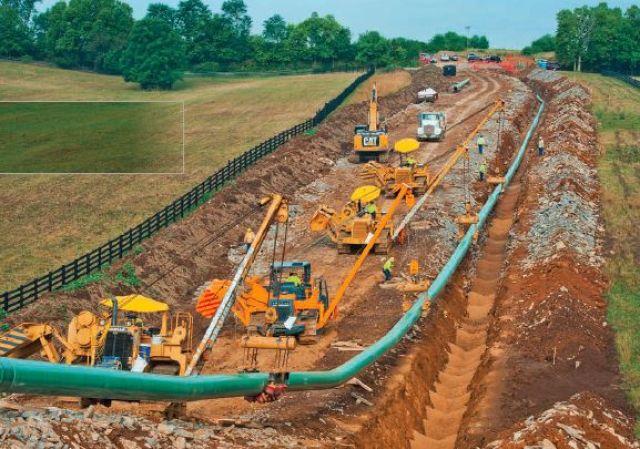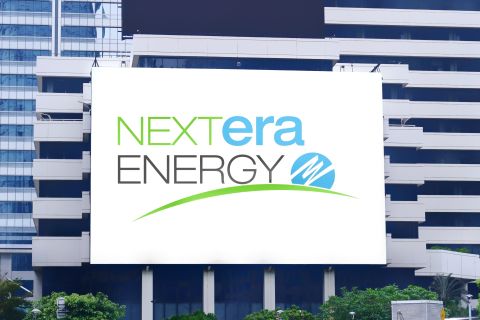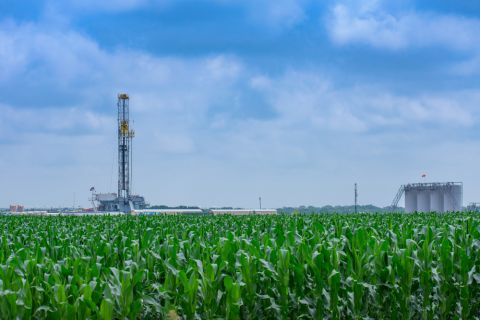
MPLX LP has the good fortune to serve the giant Utica and Marcellus unconventional plays that blossomed in the Midwest backyard of its well-established parent, Marathon Petroleum Corp. (MPC). Now, couple that luck with MPLX ’s recently completed merger with gathering and processing giant MarkWest Energy Partners LP and an ambitious capital program of new pipelines, terminals and midstream infrastructure. The result? A lease-to-refi nery gate system that will offer producers the potential for better netbacks, according to the executive who keeps it all running.
MIDSTREAM You began with Mar-athon more than 35 years ago, how has the pipeline business changed during your career?
PIERSON There are a lot of the pipelines that were in operation then that are in operation today—plus a lot more. The mileage has grown signifi -cantly, but we’re still operating some of those same assets. The thing that has changed remarkably is the technology that allows us to do that and actually even improve the safety of those pipes.
We’re fi nding that years is not nec-essarily a good measure of a pipeline’s age, it’s how it was built and how it’s run that are more indicative. Some of the older pipes can be very, very safe with the technology that we’re im-plementing—and that technology is advancing pretty rapidly. The in-line inspection tools allow us to be the safe industry that we are.
I’ll say another thing that’s changed substantially is the industry’s focus on safety. We are working harder and together more as an industry than we ever have. We’re pooling our resources for research, development and exper-tise to improve standards.
One of the things in the industry is that we really don’t compete on safety; we’re there to advance each other. One of the marquee initiatives that we’ve got underway is the Pipeline Safety Management System, which is API Rec-ommended Practice 1173. That was is-sued July 8 of last year and the industry is working hard to get it implemented.
It’s just a journey for all of us, we’re all in different places, and we’re sharing where we are and sharing ideas on how to improve. It’s things like this that are different today than yesterday. I think if the public and our regulators could watch us work together, they would be impressed with how we do it.
MIDSTREAM Moving natural gas out of the Appalachian plays has re-ceived a lot of industry attention. But what about condensate and NGL? Is the midstream meeting producers’ needs for those products?
PIERSON I think we’re meeting the need—but there is a need for additional services. Right now, there’s a lot of truck and rail business. Some of these com-modities are underserved by pipelines, and we’ve got a project underway that’s going to help meet some needs and connect producers with demand in the Midwest. I think that’s going to help our producers improve their netbacks. It’s the transportation that’s needed in the market right now.
Our Cornerstone Pipeline project, Utica build-out pipeline projects and the combination with MarkWest is going to help the Appalachian shale plays. As we combine the interest in MarkWest and the legacy MPC and MPLX assets, I think we are going be able to improve the netbacks of produc-ers in ways that they will find attractive in a difficult market. We are under-served with pipelines, and MPLX is going to help fill that void soon.
MIDSTREAM Looking to the future, how is the liquids pipeline business changing?
PIERSON Well, the environmental opposition obviously can be remarkable at times. Fortunately, we have not had huge environmental opposition to our projects. Our regulations are chang-ing—and should be. Some of those changes we certainly can support.
In this regard we can repurpose pipelines and use headroom in pipe-lines. We’re doing that with our Corner-stone Pipeline and the Utica build-out projects; reversing pipelines, expanding pipelines, along with building new ones. The industry has been doing that and we will certainly be participating, try-ing to provide solutions for NGL is an emerging need.
MIDSTREAM Why are Marathon Petroleum and MPLX so focused on the Appalachian shale plays?PIERSON From an MPC perspective, it’s in our backyard. It was kind of excit-ing when we first started following the Utica closely. We had just separated into an upstream, publically traded enterprise [Houston-based Marathon Oil Corp.] and downstream, publically traded enterprise [Findlay, Ohio-based Marathon Petroleum Corp.]. While we were doing that, we were watching the Utica play. We realized that there was a tremendous opportunity for MPLX to serve the Utica.
Since then, as we were exploring those opportunities, we got to know MarkWest. When you look at Mark-West’s footprint, they are the largest, most trusted midstream processor in the basin. The MarkWest Utica facilities will be connected with the Cornerstone Pipeline; it is just a huge focus of ours, and we’re excited to be in it and partici-pating with the producer customers.
MIDSTREAM The Utica has been a focus for MPLX, including the new Cornerstone Pipeline mentioned. What is the schedule for your projects in the region?
PIERSON The Cornerstone Pipeline is the first piece—that’s our backbone. It should be operating into MPC’s Can-ton, Ohio, refinery, moving condensate there, in late 2016. We have all of our permits, we have our right of way, and we will be mobilizing in a matter of weeks to meet that schedule.
Beyond that, what we call our Utica build-out projects will enable us to serve multiple markets from Lima, Ohio, and we will be reversing pipelines into MPC’s Robinson, Ill., refinery. We will have some of that done in early 2017 and some later in 2017.
At the head end of the pipeline, we connect to MarkWest [condensate stabilizer] at Cadiz, Ohio, and UEO [condensate stabilizer and fraction-ator] at Scio, Ohio, and we’re looking at accelerating the connection to MarkWest [fractionator] at Hopedale, Ohio. We’re working to see how fast we can get it done, perhaps in 2016, and be able to improve netbacks
for some of our customers served at MarkWest, Hopedale.
MIDSTREAM Could you explain the scope of these pipeline projects? You have a lot going on right now. PIERSON The Cornerstone Pipeline is a 16-inch line that’s designed for service of condensate, natural gasoline and natural gas liquids. Its origin is at MarkWest, Cadiz, then it picks up UEO, Scio, then we’re looking at extending to another origination at MarkWest, Hopedale. That 16-inch pipeline is bout 50 miles and it delivers to an existing light products terminal at East Sparta, Ohio. From there, MPLX will connect to MPC’s Canton refinery with an 8-inch line to feed the condensate splitter built at Canton.
From East Sparta, we connect to some existing MPLX light products pipelines, which we’re going to expand, and we will transport the condensate and natural gasoline for shippers. We will batch condensate and natural gas-oline with existing light products and haul it up to Harpster, Ohio, through two MPLX light products systems. MPLX is also building a new 50-mile pipeline that that will cut over from Harpster, Ohio, straight west to Lima.
Once we get to Lima, we have a lot of great options to serve the market. We’ve got refiners there at Lima and refiners north in Toledo, Ohio, and Detroit, and the reversed RIO pipeline to Robinson. From Robinson, we can connect to ad-ditional MPLX light products systems.
I guess one of the other things that we’re seeing is that, while we’re con-nected to some of our head end facilities via truck, they are close enough that we can actually get some Marcellus condensate flowing into the pipe—it’s not just Utica condensate. We’re able to access the Marcellus.
MIDSTREAM You will open up a lot of new markets to Utica and Marcellus producers through these projects. PIERSON Yes, MPLX is going to have connections to seven refineries, three of them are MPC’s at Canton, Detroit and Robinson. The other four are Lima, two in Toledo and a refinery at Mount Vernon, Ind. That’s pretty darn good connectivity! We will connect producer customers with demand that’s not just MPC—it’s an industry solution.
Then we have some connections we can make with Enbridge’s Southern Lights Pipeline in the Chicago market for diluent, again using some of our existing light products systems to get us there. We have a potential project to connect into the Kinder Morgan Cochin Pipeline in Michigan, also for diluent movements. So we have quite a bit of connectivity that we can offer quickly and at competitive prices.
MIDSTREAM Does MPC have any success stories to share to date in the Utica Shale?
PIERSON We surely think we do! As I’ve said, we saw the Utica starting to develop and we watched it closely in 2011. We knew we needed to partici-pate. We got in quickly with an eight-lane truck unload terminal at Canton, and MPC built a 25,000-barrel-per-day (bbl/d) condensate splitter at the Can-ton refinery and built a 35,000-bbl/d splitter at MPC’s Catlettsburg
[Kentucky] refinery. We’ve got a truck-to-barge facility that we built at Wells-ville, Ohio, where we have access to the water market for condensate to provide volume for the Catlettsburg refinery. We have a truck fleet that’s operating in the basin and we have a significant barge fleet that is serving the basin.
One of the things that I think is probably underappreciated is, when you have that much logistics capability, you can handle upsets in the marketplace. We have just a whole lot of flexibility. We are a logistics service provider through MPLX and we can also be a consumer through MPC. It’s hard to beat that offering.
MIDSTREAM You mentioned con-densate stabilization. For the sake of some of our readers, what is this and why is it important?
PIERSON The whole industry has struggled with stabilizing some of the condensates so that they can be safely transported, whether it be truck or barge or pipe, or stored in tanks. Quite simply, condensate stabilization is re-moving the propane and butane from the condensate. We’ve established a standard that the industry needs to meet—and it can be met. Getting con-nected to MarkWest and UEO, which are offering some very, very good stabi-lization facilities, offers what we think is the right connectivity, it’s the right way to handle stabilization issues for safe transportation.
MIDSTREAM MPLX has pointed to efforts to build “Mont Belvieu-like ca-pabilities” to the Marcellus and Utica, referring to the big NGL complex in Texas. What will that entail?PIERSON This is where the combi-nation with MarkWest puts MPLX in
a pretty remarkable place. MarkWest is the basin’s largest gas processor and fractionator. Through MarkWest, we have NGL marketing and some trans-portation solutions, and we have the transportation solutions that I men-tioned that MPLX plans to offer. As well as being a local consumer through MPC, we’re looking at long-haul options to move NGL to the Northeast and also the East Coast and the Gulf of Mexico.
So we have a full suite of process-ing and transportation solutions. In addition we’re evaluating a potential butane-to-alkylate project in the basin. I think that ultimately it’s going to benefit producer customers by im-proving their netbacks.
MIDSTREAM Marathon Petroleum recently announced a dropdown of its marine operations into MPLX. Do you expect further dropdowns in the near future?
PIERSON We anticipate the marine transaction to close in the second quar-ter of 2016, and beyond that, our spon-sor, Marathon Petroleum, has a strong portfolio of assets that can be dropped; including more pipeline assets and storage caverns, terminals and our fuels distribution business. All of that’s being evaluated. What we’ve got our sights set on is the marine drop, then we’ll be try-ing to fi gure out what’s the right timing and what goes next.
MIDSTREAM You operate on a fee-based business model but there are concerns in the investment commu-nity about counterparty commodity price risk for midstream operators. What’s your viewpoint?
PIERSON I think the strongest thing that we’ve got is participating in great plays. The Utica and Marcellus shale plays are some of the most prolifi c reservoirs that we’ve got in the United States, and if any play is going to sur-vive low commodity prices, we think it’s the Marcellus. The Utica is remain-ing strong as well. Those are the best things that we’ve got; operating in the right basins.
Also from a producer perspective, we’re not relying on just one customer. We have 160 producer customers, so that lessens some of the risk. We feel as they work through this challenging time, they are going to be able to keep fl owing as a result of effi ciency improve-ments, commodity price stabilization and capital spending management. We are fee based, and on the liquids side our fees are netted against marketing the liquids volume. So we feel like this is indeed a tough patch, but we are going to be able to work through it with our producer customers.
Paul Hart can be reached at pdhart@hartenergy.com
Recommended Reading
NextEra Energy Dials Up Solar as Power Demand Grows
2024-04-23 - NextEra’s renewable energy arm added about 2,765 megawatts to its backlog in first-quarter 2024, marking its second-best quarter for renewables — and the best for solar and storage origination.
Halliburton’s Low-key M&A Strategy Remains Unchanged
2024-04-23 - Halliburton CEO Jeff Miller says expected organic growth generates more shareholder value than following consolidation trends, such as chief rival SLB’s plans to buy ChampionX.
Enverus: Q1 Upstream Deals Hit $51B, But Consolidation is Slowing
2024-04-23 - Oil and gas dealmaking continued at a high clip in the first quarter, especially in the Permian Basin. But a thinning list of potential takeout targets, and an invigorated Federal Trade Commission, are chilling the red-hot M&A market.
Baker Hughes Awarded Saudi Pipeline Technology Contract
2024-04-23 - Baker Hughes will supply centrifugal compressors for Saudi Arabia’s new pipeline system, which aims to increase gas distribution across the kingdom and reduce carbon emissions
Ithaca Energy to Buy Eni's UK Assets in $938MM North Sea Deal
2024-04-23 - Eni, one of Italy's biggest energy companies, will transfer its U.K. business in exchange for 38.5% of Ithaca's share capital, while the existing Ithaca Energy shareholders will own the remaining 61.5% of the combined group.




